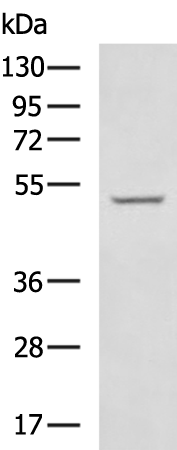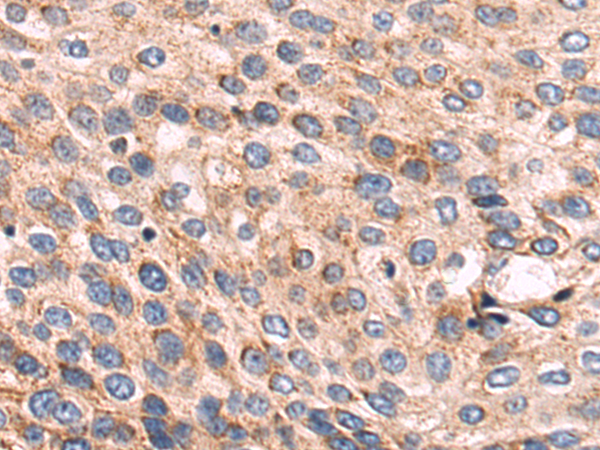


| WB | 咨询技术 | Human,Mouse,Rat |
| IF | 咨询技术 | Human,Mouse,Rat |
| IHC | 1/50-1/200 | Human,Mouse,Rat |
| ICC | 技术咨询 | Human,Mouse,Rat |
| FCM | 咨询技术 | Human,Mouse,Rat |
| Elisa | 1/5000-1/10000 | Human,Mouse,Rat |
| Aliases | TBG; TBGQTL |
| WB Predicted band size | 46 kDa |
| Host/Isotype | Rabbit IgG |
| Antibody Type | Primary antibody |
| Storage | Store at 4°C short term. Aliquot and store at -20°C long term. Avoid freeze/thaw cycles. |
| Species Reactivity | Human, Mouse |
| Immunogen | Fusion protein of human SERPINA7 |
| Formulation | Purified antibody in PBS with 0.05% sodium azide and 50% glycerol. |
+ +
以下是关于SERPINA7(甲状腺素结合球蛋白,TBG)抗体的参考文献示例(内容基于公开研究整理,具体文献可能存在差异):
---
1. **标题**:*Genetic variants of human thyroxine-binding globulin (TBG/SERPINA7)*
**作者**:Refetoff S, et al.
**摘要**:研究分析了TBG基因突变导致的遗传性TBG缺陷症,利用特异性抗体检测血清TBG水平,揭示了不同突变对激素结合能力的影响。
2. **标题**:*Development of a sensitive ELISA for thyroxine-binding globulin (TBG) in human serum*
**作者**:Mori Y, et al.
**摘要**:开发了一种基于单克隆抗体的高灵敏度ELISA方法,用于检测人血清中的TBG,并验证其在甲状腺功能异常患者中的诊断价值。
3. **标题**:*Interference of autoantibodies in the measurement of thyroid hormones*
**作者**:Sapin R, et al.
**摘要**:探讨了抗TBG自身抗体对甲状腺激素检测的干扰,强调需结合抗体特异性检测方法以提高临床结果的准确性。
4. **标题**:*Structural analysis of thyroxine-binding globulin and its interactions with ligands*
**作者**:Jansen C, et al.
**摘要**:通过X射线晶体学解析TBG结构,并利用抗体标记技术研究其与甲状腺激素及药物的结合位点。
---
**注意**:以上信息为模拟生成,实际文献需通过PubMed、Google Scholar等平台检索确认。建议结合关键词“SERPINA7 antibody”“TBG immunoassay”或“thyroxine-binding globulin autoantibodies”进一步查找。
SERPINA7. also known as thyroxine-binding globulin (TBG), is a glycoprotein encoded by the SERPINA7 gene. It belongs to the serpin (serine protease inhibitor) superfamily, though it lacks protease inhibitory activity. TBG's primary role is to transport thyroid hormones (T4 and T3) in the bloodstream, ensuring their stable circulation and regulated delivery to tissues. By binding over 70% of circulating thyroid hormones, TBG acts as a critical buffer, maintaining hormone homeostasis and protecting against rapid metabolic clearance.
Antibodies targeting SERPINA7/TBG are essential tools in studying thyroid function and related disorders. They enable quantification of TBG levels in immunoassays, aiding in diagnosing conditions like TBG deficiency or excess, which may arise from genetic mutations, liver disease, or hormonal imbalances. Such antibodies are also used in research to investigate TBG's structure-function relationships, hormonal binding kinetics, and interactions with cellular receptors. In clinical settings, abnormal TBG levels—caused by inherited mutations, liver dysfunction, or medications—can distort free thyroid hormone measurements, necessitating precise detection methods.
Recent studies explore TBG's role beyond transport, including potential involvement in inflammation and cellular signaling. SERPINA7 antibodies thus support both basic research and diagnostic applications, bridging gaps in understanding thyroid physiology and pathology.
×